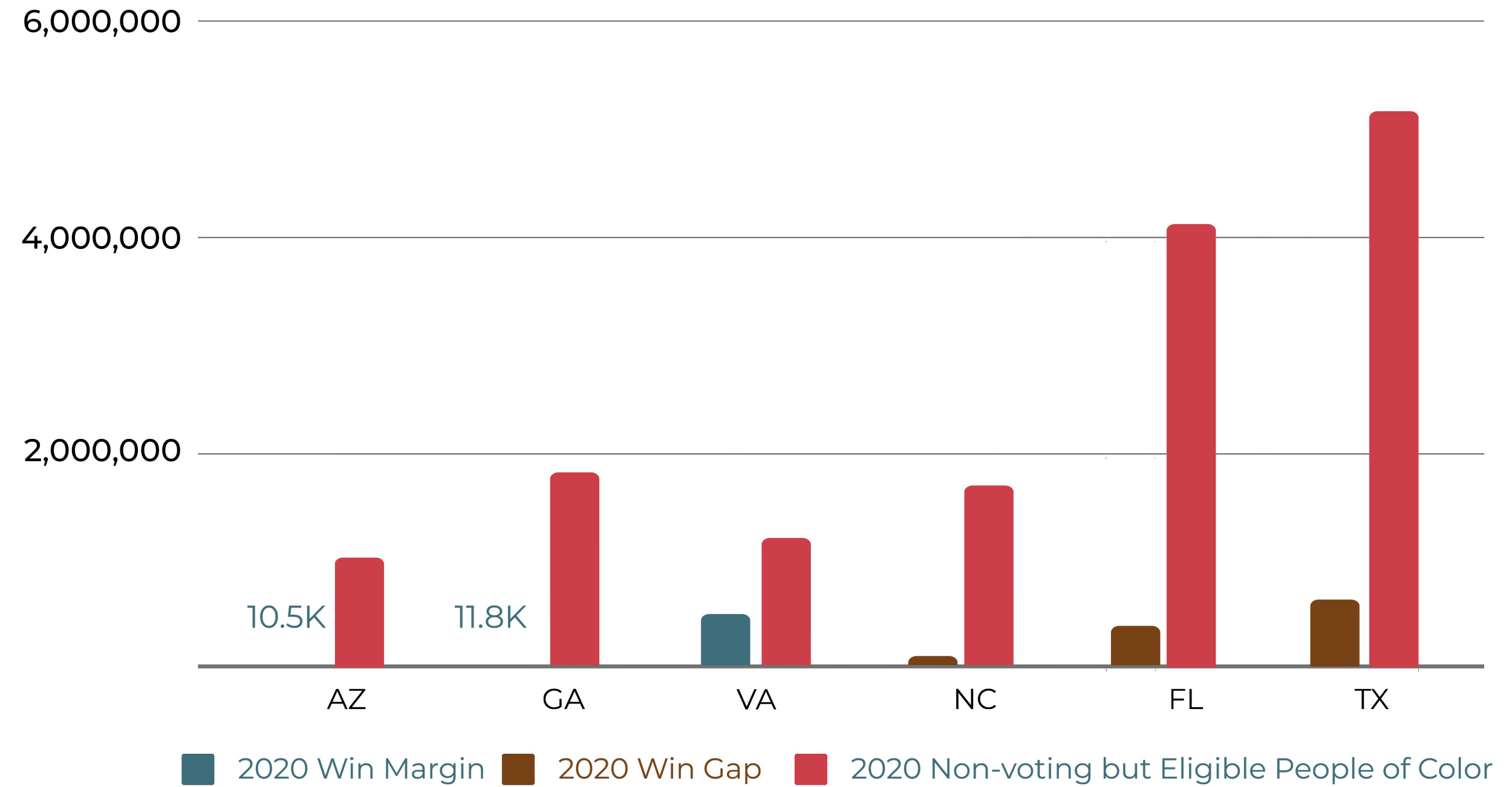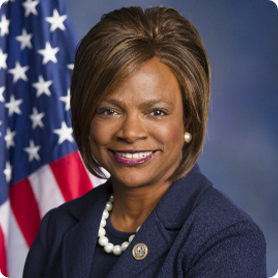Updated 2023
OUR DEMOCRACY IS IN CRISIS.
WE ARE IN A CIVIL WAR.
WE CAN AND SHOULD WIN.
The Confederate Army supposedly "surrendered" in 1865 following the "end" of the Civil War. But their fight to keep America fundamentally a white nation never stopped for 157 years.
Instead, it intensified.
Our nation has remained in an existential battle over whether this country is a multiracial democracy or a country primarily of and for white people.
Mainstream Democrats don’t get it. They continue to underestimate the power of white supremacy and the urgency of this political moment.
Those of us who do get it must clearly understand what needs to be done. We must all get on the same page about how we win.
This playbook shows us how. This playbook is for all of us.
HOW WE WIN
Recognize
the
fight
Support key
organizers
and groups
Expand
the
electorate
Mobilize
the
New American Majority
Elect effective,
unapologetic
leaders
WHY
Our side needs a battle plan
On January 6, 2021, insurrectionists stormed the U.S. Capitol brandishing weapons, waving the Confederate flag and wearing sweatshirts that read "MAGA Civil War" as they tried to stop democracy in its tracks and prevent the certification of the 2020 presidential election.
That was just two days after voters of color in Georgia helped secure a U.S. Senate majority for Democrats.
The attempted coup failed. But alarmingly, it also failed to rally Democratic party leaders into action. Democratic leadership has continued to fail to prioritize and address tackling and defeating white supremacy head on.
We're not sitting on the sidelines any longer
Good news: across the country, progressives are fighting and winning—advancing the cause of a truly multiracial democratic society.
Stacey Abrams' and other Black women-led, decade-long voter mobilization work in Georgia resulted in the elections of Raphael Warnock and Jon Ossoff to the U.S. Senate. As a result, they flipped control of the entire Senate to Democrats.
In Texas and Arizona, nonstop voter mobilization work has led to victories up and down the ballot, the result of smart, data-driven strategies rooted in justice and equality.
This proves that:
Progressives and Democrats can fight for social justice and win political battlegrounds even in traditionally Red states and locales.
Progressives and Democrats can campaign on policies that radically improve the lives of all people in this country and bring those promises to bear.
WHO IS THE
NEW AMERICAN MAJORITY?
New American Majority:
53% of Eligible Voter Population
We are the eligible voting population of Black, Latino, Asian American, Pacific Islander, Middle Eastern American, Native American, and progressive white people who, when organized, embody the winning Democratic coalition of the future.
We are 53% of the eligible voter population. Victory for Democrats and progressives in 2024 and beyond must come through us.
MONEY TALKS
& DATA TOO
Who and where to invest: South by Southwest
Thanks to organizers on the ground, we have seen the difference that mobilizing the New American Majority can make in states like Georgia and Arizona.
There’s similar potential in Texas, Florida, Virginia, and North Carolina. Investing in the South and Southwest is the clearest path to victory for Democrats.
Organizers need investment and support but too many Democrats are bad at math and can’t see the voters we need to win.
FIGHT TO WIN
A NEW ANALYSIS
Democrats can flip the balance of power across the country
By building on the demographic revolution in the South and reordering national political order, Democrats can flip the balance of power in this country for generations to come.
A deep data dive of election results over the last decade clearly shows that the path to victory runs through the South and Southwest. Specifically, there are six key states with enough eligible, non-voting people of color to drive this flip.
This is how we win
Through rigorous research and analysis, we've determined the most strategic path to victory. We've narrowed it down to six key states.
Why Arizona
In this former Confederate stronghold and Red state, Democrats have won statewide in 2018, 2020, and 2022. Arizona will be majority-people of color by 2030, just a few years away.
Latino voters make up a significant force for Democrats in this state. Arizona is 32% Latino, 5% Black, 5% Native, 4% Asian, and 53% White.
Spotlight Organization: Lucha
Why Georgia
Georgia is THE blueprint for how we win. During the 2021 GA Senate race runoffs, a ten-year organizing effort harnessed the power of the state's multiracial population to win both Senate seats for Democrats, resulting in the passage of historic and landmark legislation in Congress.
In 2022, that same organizing force led Senator Warnock to secure his reelection, helping Democrats hold onto their majority in the Senate.
Georgia is one of the Blackest states in America. According to the Census, its racial makeup is nearly half people of color. Georgia is 33% Black, 10% Latino, 5% Asian, .5% Native, and 51% White.
Spotlight Organization: Progress Georgia
Why Florida
Lost to history is the fact that Florida has 3 million eligible, non-voting people of color.
In 2018, Democrats came within 33,000 votes of winning the gubernatorial election, illuminating the potential to flip Florida with an inspired and mobilized multiracial electorate.
Spotlight Organization: Florida Rising
Why Texas
The demographic potential in Texas far surpasses even that of Georgia, with more than 4.5 million eligible people of color who didn't vote in 2020. Biden only lost Texas by a little over 630,000 votes.
According to the 2020 Census, white people now account for just 40 percent of the state population, and there are essentially as many Latinos (40 percent) as whites in the state. African Americans make up 13 percent of the state population and Asian Americans make up 5.5 percent. Native Americans make up 1%.
Spotlight Organization: Texas Organizing Project
Why North Carolina
Like many southern states, the rapid demographic changes taking place in North Carolina (a state Obama narrowly won in 2008) are transforming the state into an increasingly competitive battleground, one that can alter the political calculus in the South with the right level of investment in civic engagement organizations.
North Carolina is 22% Black, 10% Latino, 3% Asian, 2% Native, and 62% White.
Spotlight Organization: New North Carolina Project
Why Virginia
Virginia is one of the few states with elections in 2023. Democrats can retake the State Legislature this year and lay groundwork for retaking the governor’s mansion in 2025.
Despite the electoral setback during the 2021 gubernatorial race, Virginia remains a cornerstone of a progressive New American Majority. The state's multiracial coalition has transformed the former capital of the Confederacy into a beacon for democracy, and it is a state where Democrats have won nine of the past ten statewide elections.
Today more than 1 million immigrants call Virginia home and, collectively, they make up 12.5 percent of the state’s population. Virginia is 20% Black, 10% Latino, 7% Asian, 1% Native, and 60% White.
Spotlight Organization: New Virginia Majority
KEY RACES IN
2022
Races and Candidates
The top races and candidates to focus on this year are:
Georgia
Stacey Abrams
Governor
Bee Nguyen
Secretary of State
Raphael Warnock
U.S. Senate
Arizona
Mark Kelly
U.S. Senate
Katie Hobbs
Governor
Reginald Bolding
Secretary of State
Florida
Val Demings
U.S. Senate
Texas
Beto O’Rourke
Governor
Lina Hidalgo
Harris County Judge
North Carolina
Cheri Beasley
U.S. Senate
Wisconsin
Mandela Barnes
U.S. Senate
HOW TO USE THE
PLAYBOOK
As a source of analysis in
conversations with peers
Share it on social media with friends & family
As a tool to help decide who to donate to and where
SOURCES &
RESOURCES
Sources & Resources
Podcast: “How to Win with Georgia's Bee Nguyen”
Podcast: “Tram Nguyen on How Virginia Turned Blue”
Podcast: “Georgia: What Winning Looks Like”
Podcast: “Beto O’Rourke on Racial Justice & Transforming Texas”
Podcast: “Stacey Abrams: "We Have Always Found a Way Forward"
Phillips, Steve. 2017. Brown Is the New White. The New Press.
Onifade, Fola. 2021. “Black Candidates Will Help Democrats Win These 4 Swing Senate Seats in 2022.” Democracy in Color.
Nguyen, T. (2019, November 6). Democrats Could Learn a Lot From What Happened In Virginia. The New York Times.
Abrams, S., & Groh-Wargo, L. (2021, February 11). How to Turn Your Red State Blue. The New York Times.
U.S. Census Bureau website
12News.com. (2018, November 29) “All eyes will be on Arizona for how to handle majority-minority shift.”
Out Now: How We Win the Civil War
In his new book, How We Win the Civil War, Steve Phillips, founder of Democracy in Color, charts the way forward in the post-Trump era, arguing that Democrats and progressives must recognize the true nature of the fight we’re in—an existential battle between those who wish to make America a multiracial democracy and those clinging to the concept that this is fundamentally a white nation. With his trademark blend of political analysis and historical argument, Phillips lays out razor-sharp prescriptions geared toward strengthening a new multiracial democracy and ridding our nation of white supremacy for good.

































